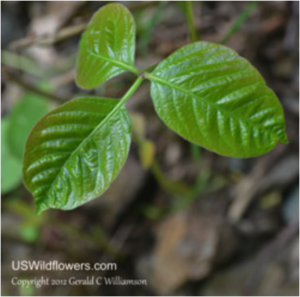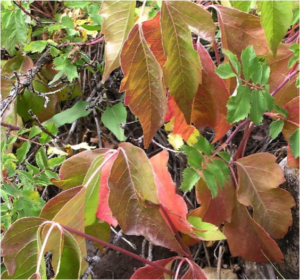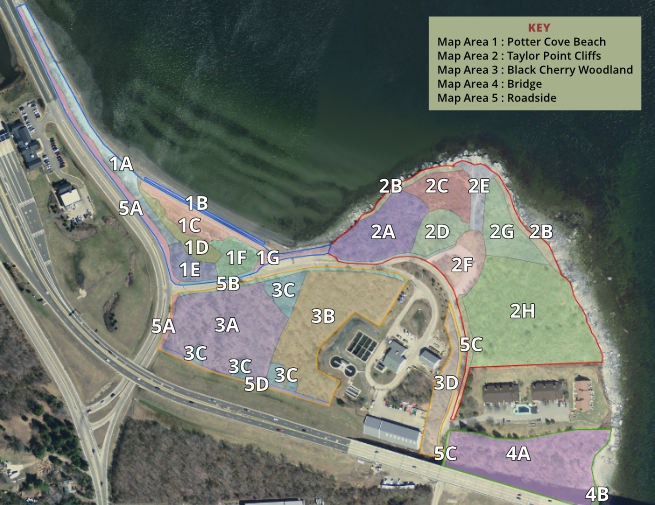Common Name: Western Poison Ivy
Specific Name: Toxicodendron rydbergii
Known Occurrence at Taylor Point:
Map Areas: Beach1A, Beach 1C, Beach 1D, Beach 1E, Beach 1F, Cliffs 2B, Cliffs 2H, Roadside 5A
Category: Native, Shrub

Ecological Considerations:
Toxicodendron rydbergii is an erect native perennial shrub that produces a woody stem, usually unbranched. Unlike the Eastern Poison Ivy it does not have aerial roots and does not climb. However, a robust plant can produce a stout woody stem reaching several feet in the air.
Leaves are alternate and divided into 3 widely oval leaflets that have a pointed tip. Side leaflets are usually shorter than the terminal leaflet. Leaves are on long hairless leafstalks that are usually attached at the top of the stem and the base of the stalk is enlarged leaving a U-shaped scar after the leaf drops away. The upper surface of the leaf is a smooth shiny dark green (bronze-green when young). Margins may be smooth or have shallow teeth. Size varies from 1 to 6 inches long and 1 to 4 inch wide. Fall color is yellow to orange-red.
The inflorescence is an elongated slightly branched panicle, with each panicle cluster having 25 or fewer stalked flowers. Flower clusters occur at the axils of the leaves at the top of the old growth stem.
The Flowers of Western Poison Ivy are very small, 5-part, with a cup shaped hypanthium with a short green calyx that has 5 triangular lobes. The corolla has 5 white to greenish-white triangular petals that spread and reflex slightly when the flower is open. There are five stamens that have white filaments and yellow anthers that surround a central pistil. The globose ovary and pistil are green with a 3 lobed stigma. Flowering time varies with the latitude.
Fruit: Flowers mature to round dry droop, green initially, turning to a dull ivory at maturity and may remain on the stem all winter. Each contains a single seed. The entire plant is toxic. All parts of the plant contain the clear colorless oil called urushiol which causes dermatitis outbreaks. Most humans are susceptible to the itchy blistering rash. For this reason the plant will be discouraged from spreading.
Map areas where this plant can be used for revegetation:
Establishment of Western Poison Ivy is discouraged.
Propagation Mechanisms/Strategies for Encouraging its Establishment:
Western Poison Ivy grows from a much branched rhizomatous base that will form colonies of plants. It grows best on wood edges and openings and in open spaces with full to at least partial sun. Soil conditions can range from poor to rich but there must be adequate moisture.
Best Planting Practices/Options and Pros and Cons of Options:
Key Issues Regarding its Ecology ( e.g. Which Invasives Threaten it, What Conditions Favor it)
Associated Ecological Benefits:
The fruit of Toxicodendron rydbergii are eaten by some birds. Animals do not appear to have ill effect from the urushiol – the oil that causes allergic reaction in most humans. Urushiol is present in all plant parts, and is the same oil in all Toxicodendron species.
Availability of Locally Sourced Seeds and Plants:
Case Studies of Native Plant Establishment Efforts/Lessons Learned:
Additional photos:


Sources cited:
Search at Rhode Island Native Plant Guide
U.S. Wildflowers.com
Friends of the Wildflower Garden
Key Words:
Native
Shrub
Western Poison Ivy
Toxicodendron rydbergii
